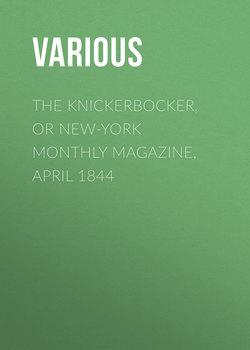Читать книгу The Knickerbocker, or New-York Monthly Magazine, April 1844 - Various - Страница 2
ILLUSTRATIONS
ОглавлениеBefore the extension of commerce and manufactories in Europe, the hospitality of the rich and the great, from the sovereign down to the smallest baron, exceeded every thing which in the present times we can easily form a notion of. Westminster Hall was the dining-room of William Rufus, and might frequently perhaps not be too large for his company. It was reckoned a piece of magnificence in Thomas à Becket that he strewed the floor of his hall with clear hay or rushes in the season, in order that the knights and squires who could not get seats might not spoil their fine clothes when they sat down on the floor to eat their dinner. The great Earl of Warwick is said to have entertained every day, at his different manors, thirty thousand people; and though the number may have been exaggerated, it must however have been very great to admit of such exaggeration. The personal expenses of the great proprietors having gradually increased with the extension of commerce and manufactures, it was impossible that the number of their retainers should not as gradually diminish. Having sold their birth-right, not like Esau, for a mess of pottage in time of hunger and necessity, but in the wantonness of plenty for trinkets and baubles, fitter to be the play-things of children than the serious pursuits of men, they became as insignificant as any substantial burgher or tradesmen in a city.
Wealth of Nations: Book iii., Chap. iv.
The planta-genista or broom having been ordinarily used for strewing floors, became an emblem of humility, and was borne as such by Fulke, Earl of Anjou, grandfather of Henry II., King of England, in his pilgrimage to the Holy Land. The name of the royal house of Plantagenet is said to be derived from this circumstance.
Hunt’s Exemplars of Tudor Architecture.
Eleven continued to be the dining hour of the nobility, down to the middle of the seventeenth century, though it was still kept up to ten o’clock in the Universities, where the established system is not so easily altered as in private families. ••• The lord and his principal guests sate at the upper end of the first table, which was therefore called the lord’s board-end. The officers of his household and inferior guests at long tables below in the hall. In the middle of each table stood a great salt-cellar, and as particular care was taken to place the guests according to their rank, it became a mark of distinction whether a person sate above or below the salt. ••• Pewter plates in the reign of Henry VIII. were too costly to be used in common by the highest nobility. In Rymer’s Fœdera is a license granted in 1430 for a ship to carry certain commodities for the express use of the King of Scotland, among which are particularly mentioned a supply of pewter dishes and wooden trenchers. ‘Octo duodenis vasorum de pewter, mille et ducentis ciphis ligneis.’
Archæologia.
The use of forks did not prevail in England till the reign of James I.
Coryat.
In the list of birds served up to table were many fowls which are now discarded as little better than rank carrion, such as cranes, lapwings, sea-gulls, bitterns, ruffs, kerlews, etc.
Grose’s Antiq. Repertory.
The use of coaches is said to have been first introduced into England by Fitz-Allan, earl of Arundel, A. D. 1580. Before that time ladies chiefly rode on horseback, either single on their palfreys, or double, behind some person on a pillion. In cases of sickness or bad weather, they had horse-litters and vehicles called chairs, or carrs, or charres. Glazed windows were introduced into England, A. D. 1180.
Anderson’s History of Commerce.
The ceilings of that part of Wresill Castle left standing by the Commonwealth’s soldiers still appear richly carved, and the sides of the rooms are ornamented with a great profusion of ancient sculpture finely executed in wood, exhibiting the ancient bearings, crests, badges and devices of the Percy family, in a great variety of forms, set off with all the advantages of painting, gilding and imagery. ••• Noblemen in Henry the Eighth’s time were obliged to carry all the beds, hangings and furniture with them when they removed. The usual manner of hanging the rooms in the old castles was only to cover the naked walls with tapestry or arras hung upon tenter hooks, from which they were easily taken down upon every removal. On such an occasion the number of carts employed in a considerable family must have formed a caravan nearly as large as those which traverse the deserts of the East. ••• At the time of the Northumberland House-hold book, glass, though it had perhaps been long applied to the decorating churches, was not very commonly used in dwelling-houses or castles.
Archæologia.
Rooms provided with chimnies are noticed as a luxury by the author of Pierce Ploughman. ‘Now,’ says an author still more recent, ‘have we many chimnies, and yet our tenderlings complain of rheums, catarrhs and poses, (colds in the head.) Then had we none but rere dosses, (plates of iron or a coating of brick to enable the wall to resist the flame,) and our heads did never ache. For as the smoke in those days was supposed to be a sufficient hardening for the timber of the house, so it was reputed a far better medicine to keep the good man and his family from the quacke, (ague,) or pose, wherewith, as then, very few were oft acquainted.’
Harrison’s Description of England prefixed to Holinshed.
